The Corpses of the De Witt Brothers
The Corpses of the De Witt Brothers is a c.1672-75 oil on canvas painting by the Dutch Golden Age painter Jan de Baen, now in the Rijksmuseum in Amsterdam.[1]
| The Corpses of the De Witt Brothers | |
|---|---|
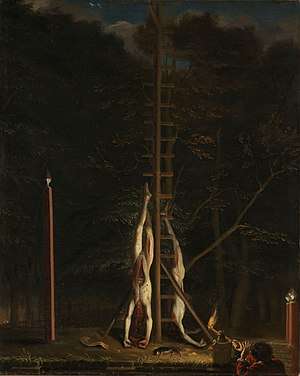 | |
| Artist | Jan de Baen |
| Year | between 1672 (event) and 1675 |
| Medium | Oil on canvas |
| Dimensions | 69.5 cm × 56 cm (27.4 in × 22 in) |
| Location | Rijksmuseum, Amsterdam |
It shows the dead and mutilated bodies of the brothers Johan and Cornelis de Witt hanging upside down on the Groene Zoodje, the place of execution in front of the Gevangenpoort in The Hague.[2][2]
Subject
The two de Witt brothers, republicans and opponents of the House of Orange, had dominated Dutch politics for some years, but left the country unprepared for the invasion by Louis XIV of France in 1672, the infamous rampjaar.[3] Their killing, which took place on 20 August 1672, was an act of aggression of a furious local mob, supporters of the 22 year old William of Orange who had just been appointed stadtholder and commander-in-chief of the army and navy by the political opponents of Johan. Johan had agreed to his forced resignation, but had also been imprisoned at the Gevangenport and his brother Cornelis, hearing the news, decided to go to his aid and was lynched himself on arrival.
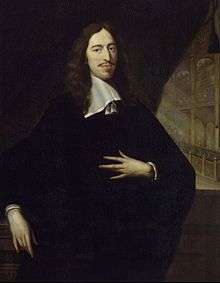 Johan, copy of portrait by de Baen
Johan, copy of portrait by de Baen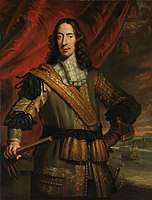 Cornelis, copy of portrait by de Baen
Cornelis, copy of portrait by de Baen
Artist
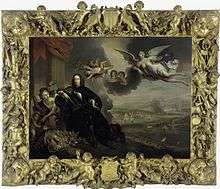
De Baen, a leading portraitist based in The Hague, had also painted individual portraits of both brothers, and The Apotheosis of Cornelis de Witt, with the Dutch Raid on the Medway in the background, which had been commissioned by the Dordrecht City Hall, because Cornelis de Witt first became mayor in 1650. In 1667 he had supervised the Raid on the Medway, which had been celebrated as a great victory and which had been planned by his brother Johan. The city hall painting in Dordrecht was destroyed at the same time as the mob in The Hague lynched the brothers, such was the state of the country in the rampjaar. The modello was purchased by Alexander Gogel in 1806, followed by copies of Jan de Baen's portraits of the brothers in 1808.[4]
Provenance and other depictions
This painting has been considered a highlight of the national history collection since it was bought in 1802 by Alexander Gogel for the high price of nearly 1000 guilders and has been on show ever since, though mostly only displayed in rooms with anatomy scenes out of respect for the effect it may have on casual visitors. It was purchased for the National Kunst Galerie in the Hague, against the advice of Cornelis Sebille Roos, who felt it should be covered with a curtain. The same subject was a popular print by Roelant Roghman, and Roos also claimed it was a copy after a print and not by Frans van Mieris as the seller had advertised. It was reattributed to Jan de Baen soon after the purchase.
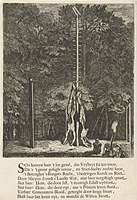 Print by Roghman
Print by Roghman Anonymous print
Anonymous print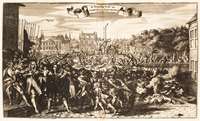 Anonymous print
Anonymous print
References
- painting record in the RKD
- Catalog entry in museum website
- Byrne, Eugene. "Is it true that an angry mob of Dutchmen killed and ate their own prime minister in 1672?". HistoryExtra.
- Catalogue of Paintings in the Rijksmuseum Amsterdam, 1960
- SK-A-15 painting record on museum website
- Rijksmuseum Amsterdam: The Masterpieces Guide, by Marleen Dominicus van Soest, 2003–2009, page 33
- Pantheon der Gouden Eeuw : van Nationale Konst-Gallerij tot Rijksmuseum van Schilderijen (1798-1896), thesis by Ellinoor Bergvelt for the University of Amsterdam, 1998